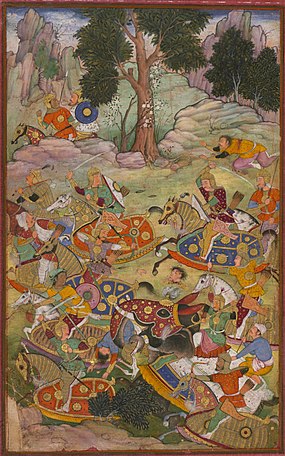Bitva u Pánípatu (1526)
| První bitva u Pánípatu | |||
|---|---|---|---|
| konflikt: Mughalská expanze | |||
 Bitva u Pánípatu a smrt sultána Ibráhíma. Ilustrace z Rukopisu Baburnama (Paměti Báburovy) z konce 16. století. | |||
| Trvání | 21. dubna 1526 | ||
| Místo | Pánípat (dnešní Harijána), Indie | ||
| Souřadnice | 29°23′24″ s. š., 76°58′12″ v. d. | ||
| Výsledek | vítězství Tímúrovců, vyplenění Dillí | ||
| Změny území | anexe a zánik Dillíského sultanátu, vznik Mughalské říše | ||
| Strany | |||
| Velitelé | |||
| Síla | |||
| |||
| Ztráty | |||
| |||
| Některá data mohou pocházet z datové položky. | |||
Bitva u Pánípatu (též první bitva u Pánípatu) proběhla v roce 1526 a střetly se zde armády Bábura z Tímúrovské dynastie a Ibráhima Lódího z dynastie Lódiů. Bitva skončila vítězstvím Bábura, který zde položil základ mughalské říše, a smrtí Ibráhíma Lódiho, který se stal posledním sultánem dillíského sultanátu.
Pánípat se nachází v dnešní Harijáně.
Externí odkazy
 Obrázky, zvuky či videa k tématu Bitva u Pánípatu na Wikimedia Commons
Obrázky, zvuky či videa k tématu Bitva u Pánípatu na Wikimedia Commons
Média použitá na této stránce
Illustrations from the Manuscript of Baburnama (Memoirs of Babur) - Late 16th Century
Bāburnāma is the memoirs of Ẓahīr ud-Dīn Muḥammad Bābur (1483-1530), founder of the Mughal Empire and a great-great-great-grandson of Timur. It is an autobiographical work, originally written in the Chagatai language, known to Babur as "Turki" (meaning Turkic), the spoken language of the Andijan-Timurids. Because of Babur's cultural origin, his prose is highly Persianized in its sentence structure, morphology, and vocabulary,and also contains many phrases and smaller poems in Persian. During Emperor Akbar's reign, the work was completely translated to Persian by a Mughal courtier, Abdul Rahīm, in AH (Hijri) 998 (1589-90).
These Paintings, being a fragment of a dispersed copy, was executed most probably in the late 10th AH /16th CE century. It contains 30 mostly full-page miniatures in fine Mughal style by at least two different artists. Another major fragment of this work (57 folios) is in the State Museum of Eastern Cultures, Moscow.Flag of the Sultanate of Delhi according to the Catalan Atlas (1375). The flag is grey with a black band in the Catalan Atlas (attached image), not green with a black band as previously uploaded.
The actual grey and black color appears clearly in the primary source (and the Catalan Atlas has plenty of green otherwise, so the grey cannot be a result of color fading), and this interpretation is confirmed by academic sources:
REFERENCE: "....that helps to identify yet another curious flag found in northern India – a brown or originally sliver flag with a vertical black line – as the flag of the Delhi Sultanate (602-962/1206-1555)." in (2010). "On the Timurid flag". Beiträge zur islamischen Kunst und Archäologie 2: 148.
WARNING: This is primary source image, the actual flag is otherwise unknown. The main source pointing to this design is the Catalan Atlas, which as a historical primary source. This image should not be added to articles without clearly attributing its primary source origin, and secondary sources are additionally desired if available (such as the one above). Note that FOTW (where most of those flags on Commons are adapted from) is based on user contributions like Wikipedia, and hence not authoritative.
OVERWRITING OF FICTIONAL FLAG:


